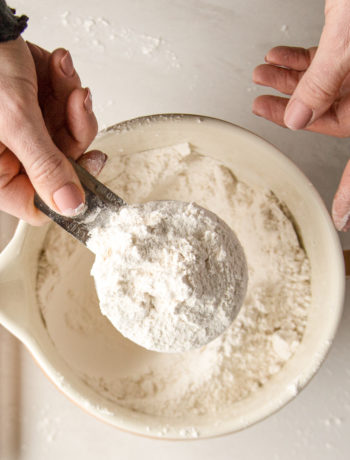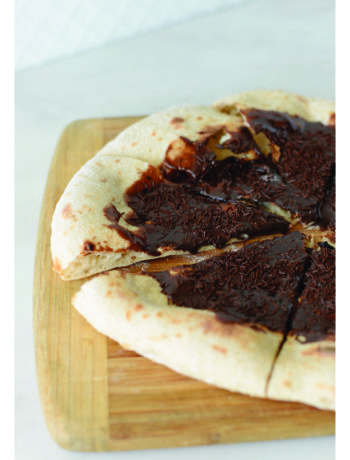These delicate cookies are notorious for being finicky and challenging to master. The key to perfect macarons is whipping the meringue until it forms stiff peaks and has a glossy shine. Many recipes provide mixing times or intervals for making macarons. The truth is there is no exact timeline because each mixer is different. Instead of focusing on time, it is more important to pay attention to how your meringue looks.
Tips from the baker
Meriel from Mmm Desserts helped us make macs in all of our mixers. Here are her key takeaways so you can have success no matter your mixer:
• If using a KitchenAid mixer, be sure that your wire whisk attachment fits properly. To test this, you’ll turn on your mixer with the whisk attachment on and listen to see if the wires are hitting the bowl. If they are, you’ll want to switch out your attachment or adjust your mixer so this doesn’t happen. Ideally, the whisk won’t touch the sides of the bowl and you won’t hear anything except for the mixer running when it is turned on.
• Another very important tip for making macarons is making sure your bowl and attachments are completely free from any fat, oil, or grease. Meringue is incredibly delicate and even the smallest amount of oil can cause it to fail.
• The main things you’re looking for in a meringue are bubbles/froth, “tails”, soft peaks, stiff peaks, and a glossy shine. Shortly after you begin whipping a meringue, you’ll start to see some bubbles or froth form. Tails are small lines that begin to form soon after the mixture has frothed and indicate that the soft peaks stage is near. Once the meringue hits soft peaks, stiff peaks aren’t far off and this is where it is important to monitor the meringue carefully. Pause frequently and look for stiff peaks with a glossy shine before folding in the almond flour by hand (or “macaronaging”).
• Don’t be afraid to stop and check where your meringue is throughout the entire process! Pay attention to how your meringue looks rather than how long you’ve been mixing. Mixer speed is also important because each mixer goes at its own speed. For example, a 5-quart KitchenAid goes faster than a 6-quart because it has less surface area to cover. To make macarons, you’ll start on a lower speed and gradually work your way up in increments no matter what type of mixer you use. As you increase the mixer’s speed, you can pause and check the consistency of your meringue until you can identify where you’re at in the process.

Now, here are the results from the macaron mixer test:
5-quart KitchenAid (PURPLE)
We did the 5 and 6-quart KitchenAid tests side by side to see the difference between mixers and we were blown away by how different they were! The 5-quart really goes much faster than the 6-quart which we think is great if you don’t want to be in the kitchen as long. Shortly after it began to foam, tails started to form. At this point, we checked the meringue every 30 seconds for soft peaks. Once we saw soft peaks, we checked the meringue every 2-5 seconds to see if stiff peaks formed. After we identified stiff peaks, we folded in the almond flour and piped out our cookies.
6-quart KitchenAid (PINK)
Because the 6-quart KitchenAid is slower compared to the 5-quart, we think it’s a better choice for macaron beginners. It takes a little bit longer to reach stiff peaks, but not much (maybe a couple of extra minutes.) Because it takes longer, we didn’t check this meringue as frequently. It did reach stiff peaks and had a glossy shine, but we were a little worried that we slightly undermixed it. We noticed that the 6-quart takes longer. We ended up bumping the mixer up to a faster speed. Once tails began to form, we checked it every two minutes for the desired stiff peaks. We then folded in the almond flour and piped our cookies.
Bosch (GREEN)
None of us have ever used a Bosch to make macarons before. Luckily we had Meriel with us. She watched the mixture very carefully so we could identify the different stages of the meringue and make sure we weren’t over whipping. At 1 minute and 50 seconds, tails began to appear while mixing at the lowest speed. At this point, we bumped it up to a speed 2 and mixed it for 5 minutes until we saw soft peaks form. We noticed that the meringue looked very different than what the KitchenAids produced. We increased the speed to a 3 for about 1-2 minutes until we reached stiff peaks. It took a total of 7 minutes and 15 seconds to whip our egg whites. It was really hard to tell if the meringue was done and once we poured it out into the dry ingredients, we noticed a grainy texture that may have signaled a broken meringue. The Bosch’s column made it difficult to pour the wet ingredients into the dry which resulted in a little bit of waste. Once combined with the almond flour, the egg whites looked more syrupy instead of air being whipped into it.
Nutrimill (YELLOW)
After finding some issues with our Bosch meringue, we watched the Nutrimill’s extremely closely so we wouldn’t overmix it. At around 3 minutes, the egg whites began to froth. We bumped the speed up to a 4 around 3 minutes and 45 seconds. At 5 minutes and 10 seconds, we paused and added food coloring and vanilla. Soft peaks began forming around 5 minutes and 30 seconds. We reached the desired stiff peaks at 6 minutes and 45 seconds. While the Nutrimill’s bowl had some of the same design issues that the Bosch had, we liked the results of Nutrimill better than Bosch. We really like that Nutrimill has more speed settings. This means you can go slower and allow the sugar to fully dissolve in the egg whites. Overall, the Nutrimill lets you have better control over your meringue.

So… What is the best mixer for macarons?
Once baked, the KitchenAid 5-quart macaroons were b-e-a-u-t-i-f-u-l. They had perfectly smooth tops and gorgeous feet. They had the most consistently baked macs with no cracks. The 6-quart KitchenAid came in second. We had some issues with cracked shells which could be due to undermixing. The Nutrimill came in third with a few nice macarons. However, a lot of them had cracks and underdeveloped feet. In last place were the Bosch macarons. A majority of the batch had domed and cracked shells, but we still had a few from this batch that turned out. Would we say no to any of these macs? Of course not! Who could say no to a macaron? With more practice, we think it is possible to have success with each mixer.



